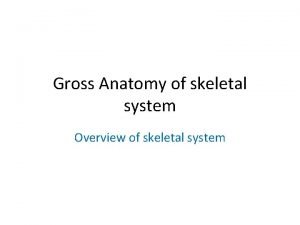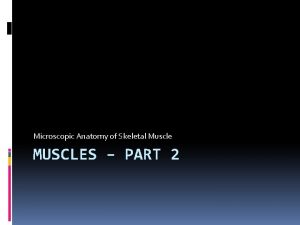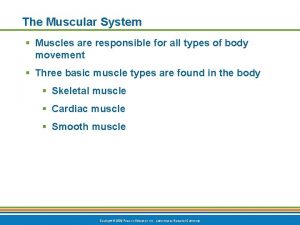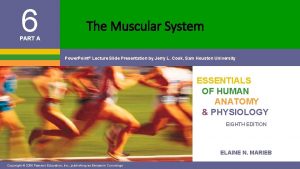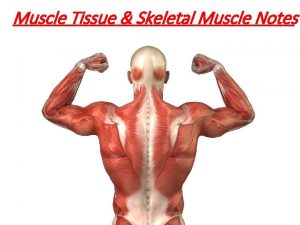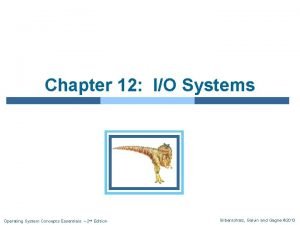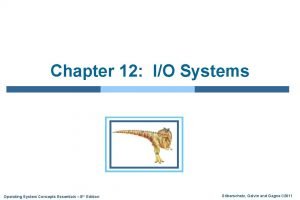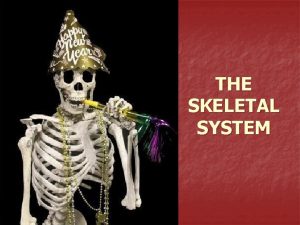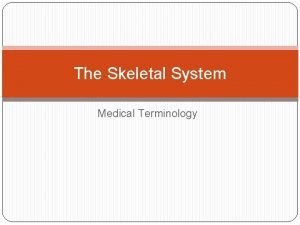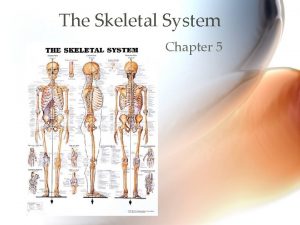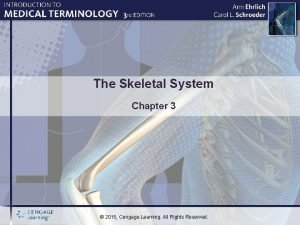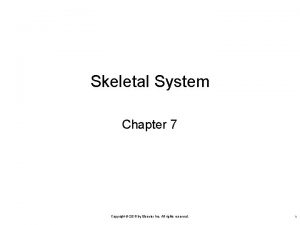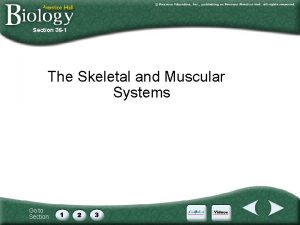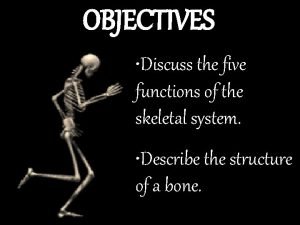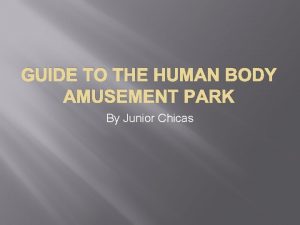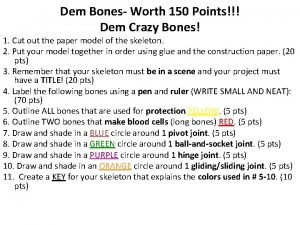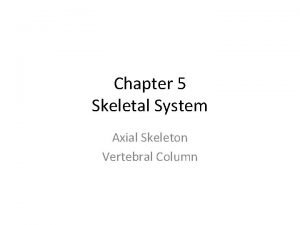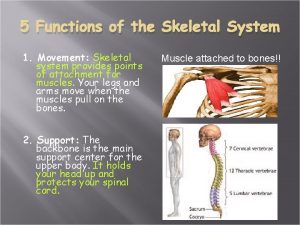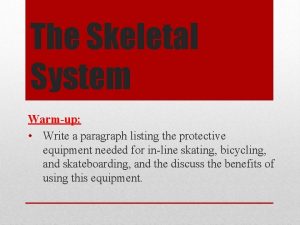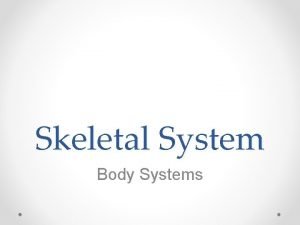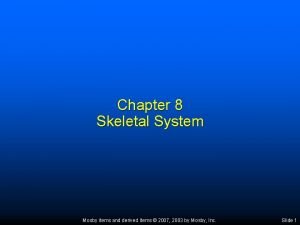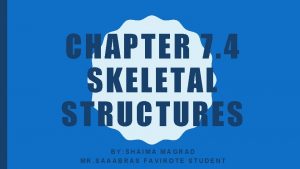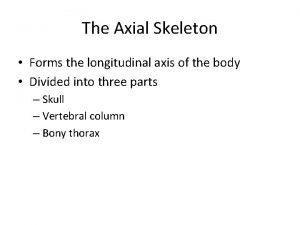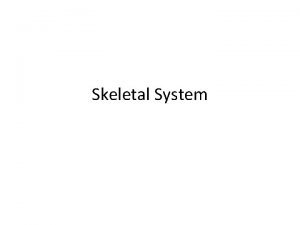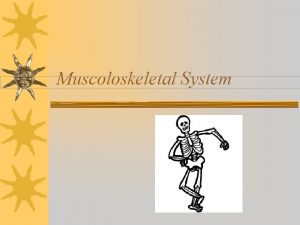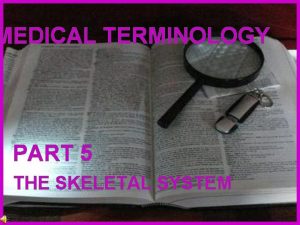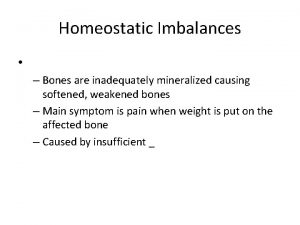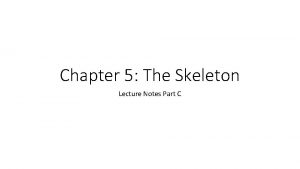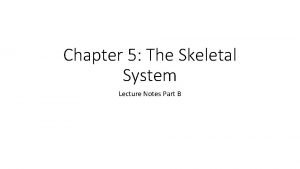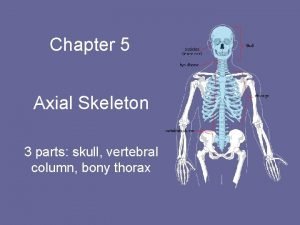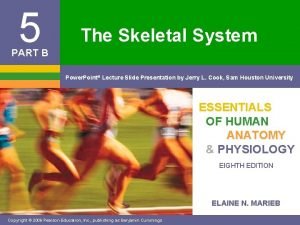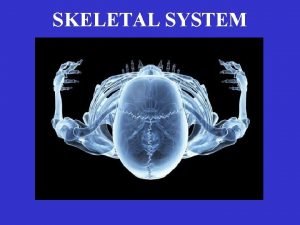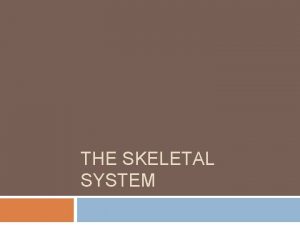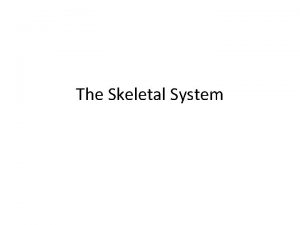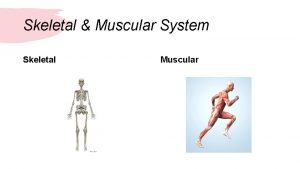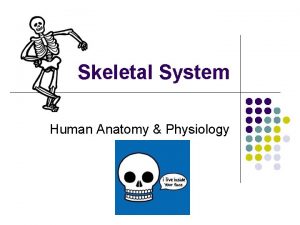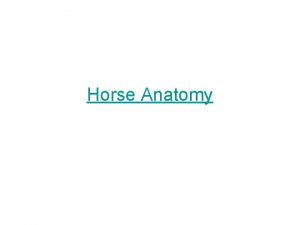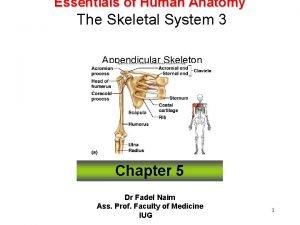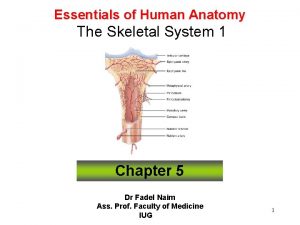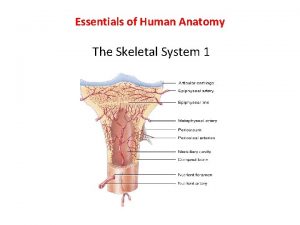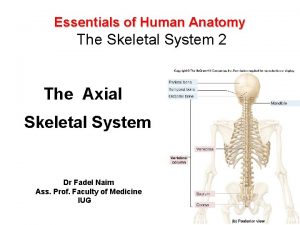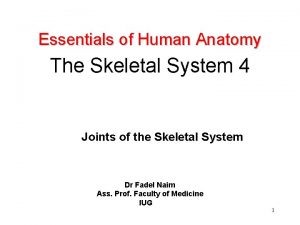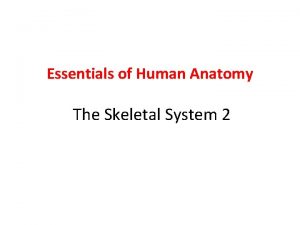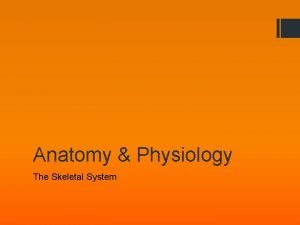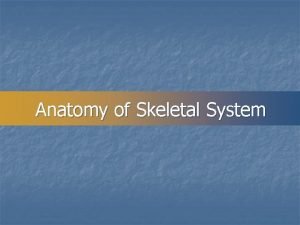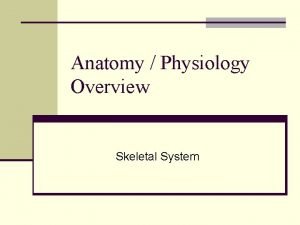Essentials of Human Anatomy The Skeletal System 3











































- Slides: 43

Essentials of Human Anatomy The Skeletal System 3 Appendicular Skeleton Dr Fadel Naim Ass. Prof. Faculty of Medicine IUG 1

The Appendicular Skeleton • Pectoral girdle – Attaches the upper limbs to the trunk • Pelvic girdle – Attaches the lower limbs to the trunk • Upper and lower limbs differ in function – Share the same structural plan

Articulated Pectoral Girdle

Appendicular Skeleton • Upper extremity – Consists of the bones of the shoulder girdle, upper arm, lower arm, wrist, and hand – Shoulder girdle • Made up of scapula and clavicle • Clavicle forms only bony joint with trunk, the sternoclavicular joint • At its distal end, clavicle articulates with the acromion process of the scapula

Pectoral Girdle • shoulder girdle • clavicles • scapulae • supports upper limbs

Clavicles • articulate with manubrium • articulate with scapulae (acromion process)

Scapulae • spine • supraspinous fossa • infraspinous fossa • acromion process • coracoid process • glenoid cavity


The Upper Limb • 30 bones form each upper limb • Grouped into bones of the – Arm – Forearm – Hand

Upper Limb • Humerus • Radius • Ulna • Carpals • Metacarpals • Phalanges

Humerus • The long bone of the upper arm • Articulates proximally with the glenoid fossa of the scapula and distally with the radius and ulna

Humerus • head • greater tubercle • lesser tubercle • anatomical neck • surgical neck • deltoid tuberosity • capitulum • trochlea • coronoid fossa • olecranon fossa

Radius – Long bone found on thumb side of forearm • Articulates proximally with capitulum of humerus and radial notch of ulna • articulates distally with scaphoid and lunate carpals and with head of ulna

Radius • lateral forearm bone • head • radial tuberosity • styloid process

Ulna • Long bone found on little finger side of forearm • Articulates proximally with humerus and radius and distally with a fibrocartilaginous disk

Ulna • medial forearm bone • trochlear notch • olecranon process • coronoid process • styloid process

Wrist and Hand • Carpals (16) • trapezium • trapezoid • capitate • scaphoid • pisiform • triquetrum • hamate • lunate • Metacarpals (10) • Phalanges (28) • proximal phalanx • middle phalanx • distal phalanx


Appendicular Skeleton • Lower extremity Consists of the bones of –Hip –Thigh –lower leg –Ankle –Foot

Pelvis • The adult pelvis is composed of four bones: – the sacrum, the coccyx, and the right and left ossa coxae. • Protects and supports the viscera in the inferior part of the ventral body cavity. • Pelvic girdle refers to the left and right ossa coxae only.

Os Coxae • Commonly referred to as the “hip bone” or innominate bone. • Each is formed from three separate bones: – the ilium – the ischium – the pubis • Each articulates posteriorly with the sacrum at the sacroiliac joint.



Pelvic Girdle • Coxae (2) • supports trunk of body • protects viscera

Coxae • hip bones • acetabulum • iliac crest • iliac spines • greater sciatic notch • ischium • ischial spines • lesser sciatic notch • ischial tuberosity • pubis • obturator foramen • symphysis pubis • pubic arch

Greater and Lesser Pelvis Greater Pelvis • lumbar vertebrae posteriorly • iliac bones laterally • abdominal wall anteriorly Lesser Pelvis • sacrum and coccyx posteriorly • lower ilium, ischium, and pubis bones laterally and anteriorly

Male and Female Pelvis Female • iliac bones more flared • broader hips • pubic arch angle greater • more distance between ischial spines and ischial tuberosities • sacral curvature shorter and flatter • lighter bones



Lower Limb • Femur • Patella • Tibia • Fibula • Tarsals • Metatarsals • Phalanges

Femur • longest bone of body • head • fovea capitis • neck • greater trochanter • lesser trochanter • linea aspera • condyles • epicondyles

Patella • kneecap • anterior surface of knee • flat sesamoid bone located in a tendon

Tibia • shin bone • medial to fibula • condyles • tibial tuberosity • anterior crest • medial malleolus

Fibula • lateral to tibia • long, slender • head • lateral malleolus • does not bear any body weight

Ankle and Foot • Tarsals (14) • calcaneus • talus • navicular • cuboid • lateral cuneiform • intermediate cuneiform • medial cuneiform • Metatarsals (10) • Phalanges (28) • proximal • middle • distal

Ankle and Foot

Arches of the Foot • The sole of the foot does not rest flat on the ground. • Helps it support the weight of the body. • Ensures that the blood vessels and nerves on the sole of the foot are not pinched when standing.

Arches of the Foot • Medial longitudinal arch extends from the heel to the big toe. • Lateral longitudinal arch is not as high as the medial longitudinal arch. • Transverse arch runs perpendicular to the longitudinal arches.


Hallux valgus • A lateral deviation of the great toe at the metatarsophalangeal joint • Its incidence is greater in women than in men • Associated with badly fitting shoes. • Often accompanied by the presence of a short first metatarsal bone. • Once the deformity is established, it is progressively worsened by the pull of the flexor hallucis longus and extensor hallucis longus muscles.

Hallux rigidus • Osteoarthritic changes in the metatarsophalangeal joint, which then becomes stiff and painful

Pes planus (flat foot) • A condition in which the medial longitudinal arch is depressed or collapsed. • As a result, the forefoot is displaced laterally • The head of the talus is no longer supported • The causes of flat foot are both congenital and acquired.

THE END
 Sally left the party to take cathy home
Sally left the party to take cathy home Pectoral girdle acetabulum
Pectoral girdle acetabulum Microscopic anatomy of skeletal muscle
Microscopic anatomy of skeletal muscle Microscopic anatomy of skeletal muscle figure 6-2
Microscopic anatomy of skeletal muscle figure 6-2 Contractile unit of muscle
Contractile unit of muscle Microscopic anatomy of skeletal muscle figure 6-2
Microscopic anatomy of skeletal muscle figure 6-2 Anatomy of skeletal muscle
Anatomy of skeletal muscle Operating system concepts essentials
Operating system concepts essentials Operating system concepts essentials
Operating system concepts essentials Five functions of the skeletal system
Five functions of the skeletal system Medical terminology skeletal system
Medical terminology skeletal system Chapter 5 the skeletal system
Chapter 5 the skeletal system Chapter 3 the skeletal system learning exercises answer key
Chapter 3 the skeletal system learning exercises answer key Chapter 7 skeletal system
Chapter 7 skeletal system Chapter 5 the skeletal system
Chapter 5 the skeletal system Section 36-1 the skeletal system
Section 36-1 the skeletal system What are the five functions of the skeletal system?
What are the five functions of the skeletal system? Nervous system amusement park
Nervous system amusement park Dem crazy bones skeleton template
Dem crazy bones skeleton template Chapter 6 skeletal system
Chapter 6 skeletal system Lamina bone
Lamina bone Chapter 32 section 2 the skeletal system answer key
Chapter 32 section 2 the skeletal system answer key Body system theme park project
Body system theme park project Skeletal system 5 functions
Skeletal system 5 functions Muscle
Muscle How to care for the skeletal system
How to care for the skeletal system 5 function of skeletal system
5 function of skeletal system Whats the main function of the skeletal system
Whats the main function of the skeletal system Chapter 8 skeletal system
Chapter 8 skeletal system Chapter 7:4 skeletal system
Chapter 7:4 skeletal system Appendicular skeleton figure 5-8
Appendicular skeleton figure 5-8 Skeleton
Skeleton The axial skeleton forms the longitudinal axis of the body
The axial skeleton forms the longitudinal axis of the body Skeletal system
Skeletal system Axial vs appendicular skeleton
Axial vs appendicular skeleton Muscolo skeletal system
Muscolo skeletal system Skeletal system root words
Skeletal system root words Homeostatic imbalances of bones and joints
Homeostatic imbalances of bones and joints Chapter 5 the skeletal system figure 5-13
Chapter 5 the skeletal system figure 5-13 Hyoid bone lecture
Hyoid bone lecture Chapter 5 the skeletal system
Chapter 5 the skeletal system Receive
Receive Chapter 3 the skeletal system labeling exercises
Chapter 3 the skeletal system labeling exercises Chapter 5 the skeletal system figure 5-10
Chapter 5 the skeletal system figure 5-10
